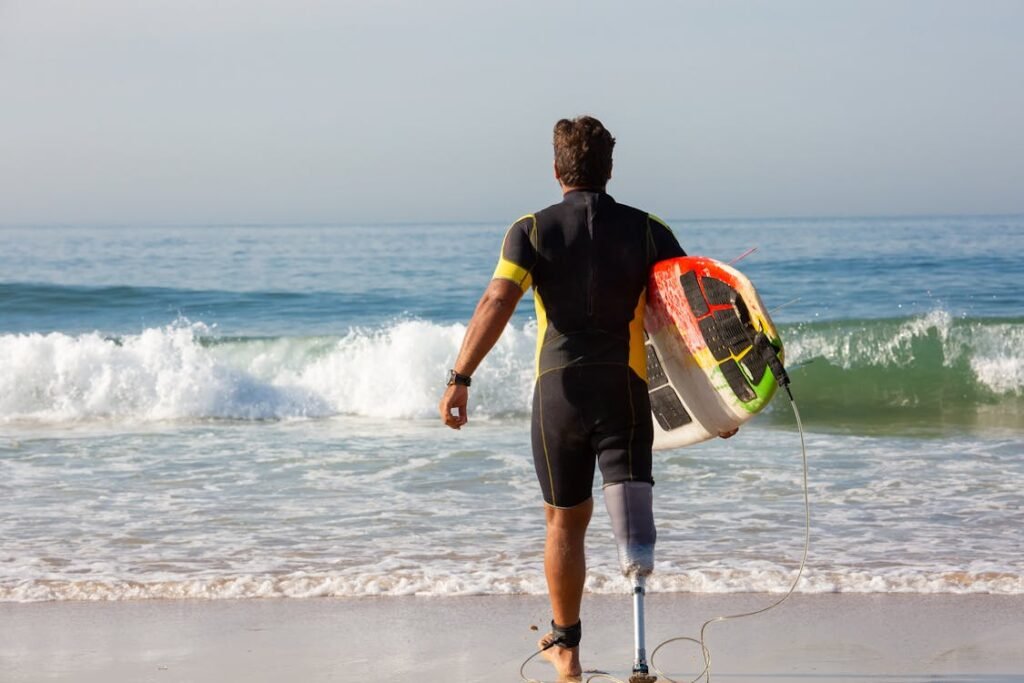Summer can be brutal. The heat rises, the humidity kicks in, and for most people, it just means discomfort and a few extra showers. But for someone wearing a prosthetic limb, summer brings an entirely different challenge—staying comfortable inside the socket.
When temperatures go up, so does sweating. And when your residual limb is sweating inside a snug socket, things can quickly go wrong. The socket may start to slip. The skin can become irritated or develop rashes. It can even lead to painful sores or infections. Suddenly, a socket that felt perfect in the cooler months becomes a daily struggle.
At Robobionics, we hear this every summer. Patients who were walking comfortably in January find themselves adjusting their socket constantly in May. Some feel like they need to sit down more often. Others avoid going outside altogether. The truth is, socket comfort isn’t just about the shape—it’s about how your skin, your body, and your socket all react to your environment. And in summer, everything changes.
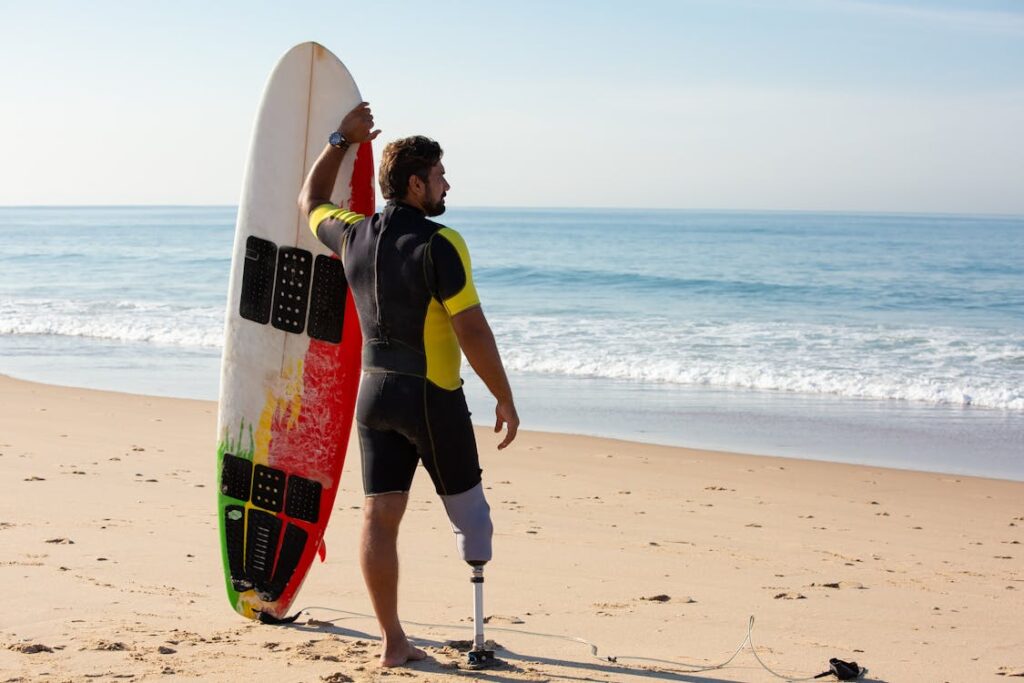
Why Summer Makes Socket Fit So Difficult
Heat Changes Everything
When your body gets hot, it tries to cool down. One way it does that is by sweating. Sweat helps bring the temperature of your skin down, but inside a prosthetic socket, it has nowhere to go.
Instead of cooling you off, the sweat stays trapped, soaking the liner or collecting against your skin. This makes the inside of the socket slippery, sticky, and sometimes even painful.
The heat also causes your residual limb to swell. Just like feet can feel tighter in shoes during hot weather, your limb can expand inside the socket.
This changes the entire fit. What felt snug in the morning might feel tight and uncomfortable by the afternoon. Or worse—it might feel loose because the sweat has made it slippery. That’s when the problems begin.
Some users notice their limb twisting slightly when they walk. Others feel the socket shifting with every step.
Even a tiny amount of movement inside the socket can cause rubbing and friction. After a few hours, this can lead to skin breakdown, redness, or blisters.
And if it keeps happening every day, that irritation can turn into more serious wounds.
The Skin Struggles in Summer
Your skin is your body’s first layer of protection. But when it’s trapped in a warm, wet space like a prosthetic socket, it becomes more fragile. Sweat makes the skin softer.
Friction makes it thinner. And bacteria love warm, moist environments. That’s why summer is the season when we see the most cases of skin infections, heat rashes, and fungal growth around the residual limb.
Many people try to solve this by washing more often, which is good. But sometimes, overwashing or using strong soaps can dry out the skin, making it more sensitive and prone to cracking.
Others switch liners or socks too often, chasing comfort but never really finding it. What they need isn’t more products—it’s a deeper understanding of what’s really going on inside that socket during summer.
We’ve also seen cases where people try to “tough it out,” thinking it’s normal to feel discomfort in the summer. They walk through the pain until the skin breaks down.
Then they have to stop using their prosthetic completely, waiting days or even weeks for the skin to heal. This break in activity not only slows progress but also affects confidence and mood.
Sweat Can Destroy Suspension
One of the less talked-about effects of summer sweat is how it affects suspension. Suspension is how your socket stays attached to your body.
Whether it’s suction-based, pin-lock, vacuum-assisted, or sleeve suspension, all these systems rely on tight contact between your limb and the socket.
When sweat builds up, that connection can fail. Suction systems lose their seal. Sleeves slide out of place. Liners start to bunch up. Suddenly, your prosthetic doesn’t feel secure anymore.
You might feel like the socket is slipping off, or you may hear strange noises with each step. That feeling of instability can lead to slower walking, uneven weight bearing, and even falls.
We’ve had users tell us they stopped trusting their prosthesis in the summer—not because it was broken, but because it didn’t feel safe.
That lack of trust becomes a mental block. They walk less, move less, and avoid activities they used to enjoy.
Proper alignment and fit are important all year, but in summer, managing suspension becomes critical. It’s not just about staying comfortable—it’s about staying upright and safe.
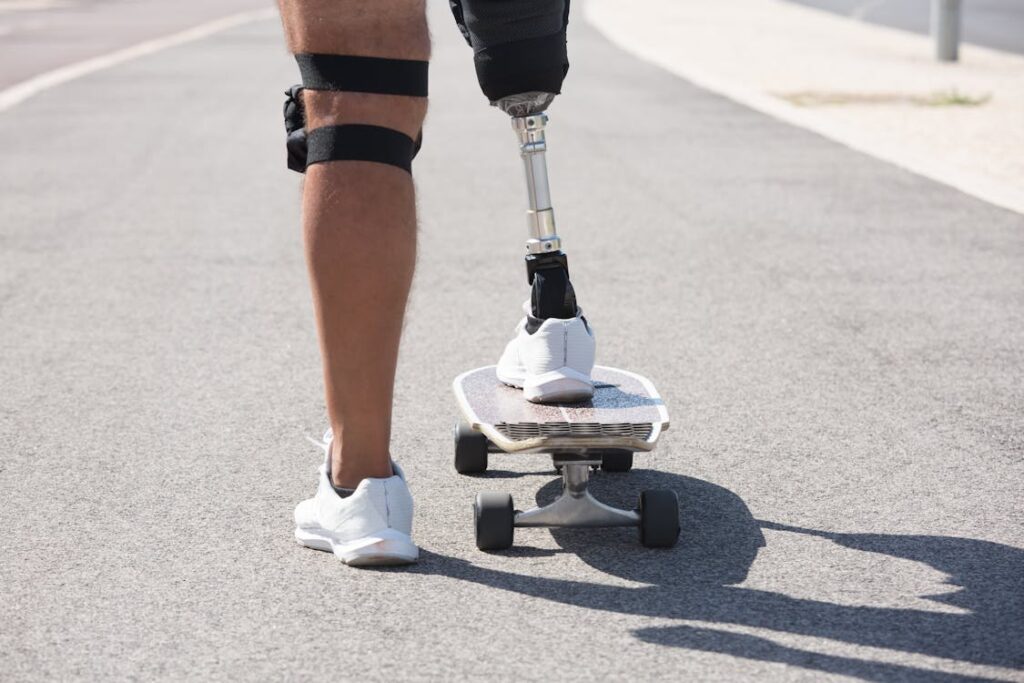
How the Body Reacts to Heat and Why It Matters for Socket Fit
Your Residual Limb Is Always Changing
One thing that often surprises new prosthetic users is how much the limb changes throughout the day. In summer, this change is even more noticeable. As temperatures rise, the blood vessels in your limb expand.
This is your body’s way of trying to cool itself. But that expansion causes swelling, and swelling affects socket fit in a big way.
In the morning, when it’s cooler, your limb might feel slightly smaller. You slip into your socket with no problem.
But by midday, especially if you’ve been moving around or spending time outside, your limb might feel swollen and tight inside the same socket.
That pressure can cause discomfort and reduce blood flow, which leads to more swelling—a frustrating cycle.
By evening, your limb might shrink again, especially if you’ve been resting in a cooler room. The socket now feels loose.
That looseness allows movement inside the socket, which leads to friction, and ultimately, skin irritation. This back-and-forth change makes summer one of the most unpredictable seasons when it comes to fit.
You might find yourself reaching for extra socks in the morning, only to remove them later. Or you might adjust your liner multiple times a day, chasing that sweet spot where the socket feels just right.
This constant micro-adjustment can become mentally exhausting over time. It wears down your patience and makes wearing the prosthetic feel like a full-time job.
The Psychological Impact of Summer Discomfort
What we don’t talk about enough is how socket discomfort affects the mind. Living with a prosthesis already demands attention and awareness.
You’re constantly checking your balance, watching your step, and staying alert to your environment. When the socket becomes an added source of discomfort—especially in summer—it makes everything feel harder.
People often describe summer discomfort as draining. They feel tired sooner. They walk less. They plan their days around when they’ll be most comfortable, avoiding outings during the hottest times.
Some stop walking altogether for hours, afraid of blisters or skin problems. Others feel embarrassed by the odor that comes from excessive sweating in the socket and start isolating themselves socially.
We’ve even heard from users who avoid using public transport during summer because they worry about their prosthesis slipping or becoming noisy from sweat buildup.
That loss of freedom hurts—not just physically, but emotionally. And it can quietly undo months of progress made during cooler months.
That’s why we always encourage our users to speak up when they notice seasonal changes. Summer discomfort isn’t a small inconvenience—it’s something that deserves attention. And it can be solved with the right approach.
Skin Health Needs a Different Strategy in Summer
Your skin behaves differently in the heat. It becomes softer, more absorbent, and more vulnerable. For prosthetic users, this means that every point of pressure, every area of rubbing, becomes more dangerous.
Even something as simple as a crease in a liner or a misaligned sock can lead to irritation that turns into a sore in just a few hours.
In summer, good skin care becomes non-negotiable. But what many people don’t realize is that skin care isn’t just about what lotion you use.
It’s about the entire environment inside the socket. If sweat is constantly being trapped, even the best skin creams can’t prevent damage.
One of the most common complaints we hear is skin maceration—that wrinkled, white appearance of skin that stays too wet for too long.
Macerated skin is weak skin. It tears easily. It doesn’t heal fast. And it opens the door to infection.
We’ve also seen fungal infections that started small but quickly spread because the warm, damp conditions inside the socket were never addressed.
These kinds of infections can take weeks to treat, and during that time, the user often has to stop using their prosthesis altogether. That’s a huge setback—physically and emotionally.
The good news is that skin issues caused by summer heat are preventable. But prevention takes more than products.
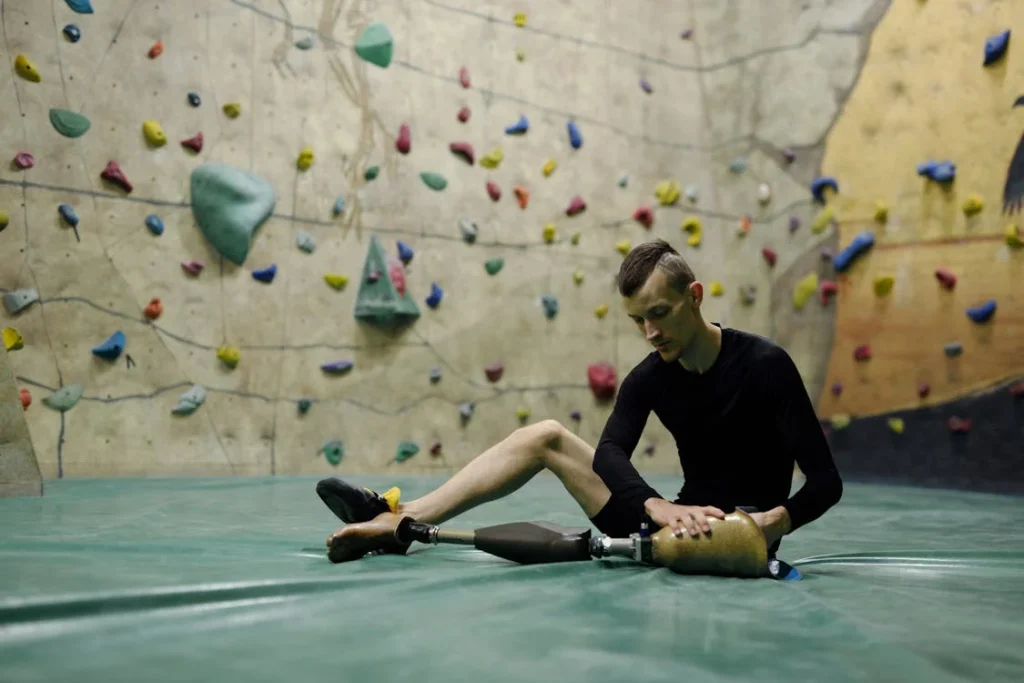
Practical Solutions for Managing Socket Fit in Hot Weather
Start the Day Right—Prepare the Limb and Socket Before You Sweat
One of the best ways to stay ahead of summer discomfort is by preparing your residual limb before you even step into your socket.
Most people wait until the problem starts—until they’re already sweating, slipping, or irritated. But by then, the damage is often underway.
At Robobionics, we suggest starting your day by cooling the residual limb. A short rinse with cool water or a clean, damp cloth can reduce early swelling and tighten the skin just enough to make donning the socket easier.
Once the skin is dry, applying a lightweight, prosthetic-safe antiperspirant can reduce sweat buildup throughout the day. These sprays or roll-ons create a light barrier that doesn’t clog the skin but helps limit moisture where it matters most.
Before putting on your liner, make sure it’s completely dry and free of any residue from previous wear. If you’re using a fabric-based liner or a gel liner, leaving it out overnight to dry completely can make a big difference.
Any moisture or bacteria left over from the day before becomes a problem the next day.
When donning the socket, take your time. Ensure the limb is properly seated, and check that there’s no air pocket or misalignment that could worsen with swelling later.
If you use prosthetic socks, make sure they are clean, dry, and not overly stretched from prior use. A good start sets the tone for a better day.
Stay Ahead of Sweat—Don’t Let It Build Up
Once the day begins and the temperature starts to climb, sweat is unavoidable. But it doesn’t have to control your comfort. The key is managing it before it builds up inside the socket.
If your lifestyle or job involves a lot of walking or standing in the heat, schedule regular “socket breaks.” Even removing the prosthesis for five minutes every few hours allows the skin to breathe and cool down.
During these breaks, gently wipe the residual limb and liner with a soft towel or skin-friendly wipe. Avoid using anything with alcohol or strong chemicals, as these can irritate the skin.
If taking the socket off isn’t an option, make small adjustments to shift pressure areas. Sometimes rotating the liner slightly, or reapplying the suspension sleeve after a short break, helps reset the contact points and reduces friction.
We’ve also found that wearing breathable clothing around the socket area helps with ventilation. Loose, light fabrics reduce heat buildup around the limb, while tight jeans or thick trousers can trap heat and increase sweat.
The main idea here is simple: don’t wait until your socket is soaked. Build a habit of staying dry throughout the day. Your skin will thank you, and your walks will be much more enjoyable.
Understand When It’s Time to Switch Socks or Liners
During summer, you might find yourself reaching for extra prosthetic socks to improve the fit. While that can help with limb volume changes, it’s important to know when you’re doing more harm than good.
Adding too many socks in response to swelling can make the socket overly tight. This leads to poor circulation, which causes even more swelling.
Instead, focus on matching your sock use to the time of day. Start with fewer socks in the morning, and increase as needed only after confirming that your limb has genuinely shrunk and the socket feels loose—not just sweaty.
The same goes for liners. Gel liners are popular for their cushioning, but in the heat, they can trap sweat against the skin. If your liner always feels damp or sticky by midday, it may be worth trying a different material or one with better moisture-wicking properties.
At Robobionics, we sometimes fit users with alternate liners for summer—lighter options that are easier to clean and faster to dry.
Rotating between two liners throughout the day can also help, especially if you’re outdoors often. Clean one while you wear the other. It’s a simple method that keeps both the skin and the liner healthier.
Monitor Skin Closely—The Signs Are There Before the Sore Appears
Your skin always gives warning signs before it breaks down. Redness, sensitivity, tingling, or a slight burning sensation after removing the socket are all early indicators.
Don’t ignore these signs. They mean that friction or moisture has already started doing damage, and it’s time to act.
The moment you notice irritation, clean the area gently and let it breathe. Avoid putting the socket back on until the redness fades, even if just for 30 minutes.
Applying a thin layer of prosthetist-approved barrier cream may help prevent further irritation—but avoid thick ointments that trap heat.
If the skin is starting to peel or feel raw, it’s time to pause. Don’t wait until it becomes an open sore. Contact your prosthetist and explain what you’re feeling.
Sometimes, a simple socket or liner adjustment can relieve the pressure that’s causing the irritation.
We always remind our users: the sooner you speak up, the faster we can help you stay on your feet.
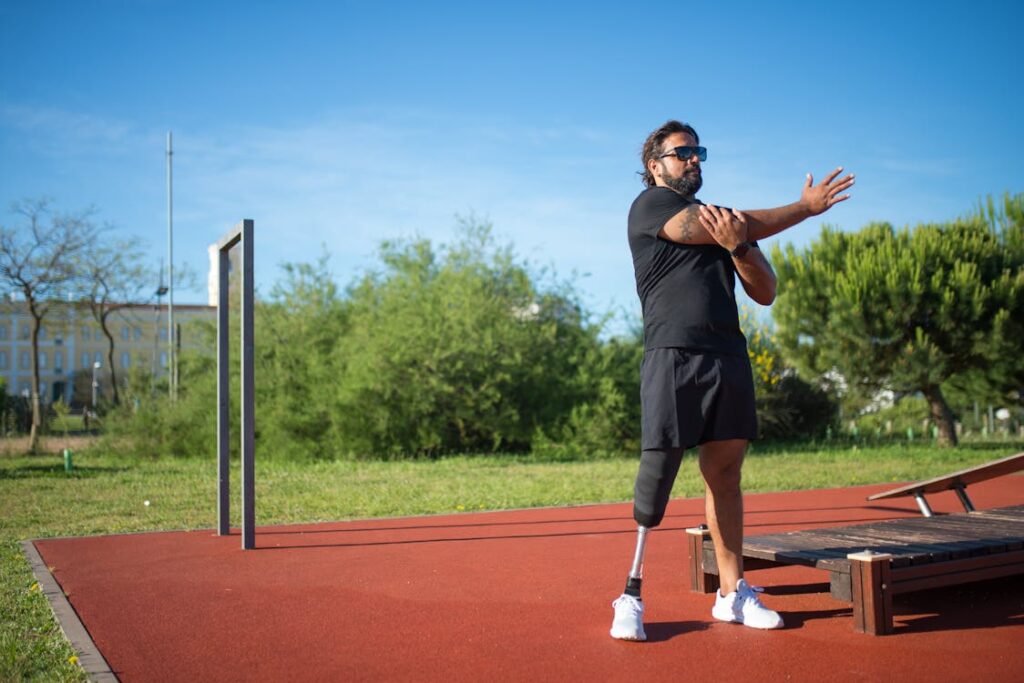
When to Consider a Summer Socket Adjustment or Refit
Your Socket May Be Perfect—But Only for Winter
Many users don’t realize that their socket, while perfectly fitted during cooler months, may not serve them as well in summer.
That’s because most fittings happen in climate-controlled environments—prosthetic labs with air conditioning, where swelling is minimal and sweat is under control. But once you step out into 40°C heat and 80% humidity, your body changes, and so does your limb.
If you find yourself constantly adjusting, adding socks, removing your limb to cool off, or dealing with repeated skin issues during summer, it could be a sign that your socket needs to be evaluated.
This doesn’t always mean you need a brand new socket—it could be a minor modification that makes a huge difference.
At Robobionics, we often do summer-specific adjustments. Sometimes it’s reshaping the socket opening for better airflow. Other times, we modify the angle slightly to accommodate seasonal swelling.
Even adding ventilation channels or switching to a softer inner liner can transform a sweaty, sticky fit into a cooler, more breathable one.
The goal is not to over-correct. We don’t want to create a loose socket that’s unusable when temperatures drop again.
Instead, we look at how your body behaves in heat and tweak the socket to keep up. These adjustments are reversible and often seasonal, allowing us to support your movement all year long.
Materials Matter More Than You Think
One of the smartest ways to deal with summer socket discomfort is to look closely at the materials you’re using. Not all sockets are made the same.
Some are built for durability. Others for lightness. In hot weather, what matters most is breathability and sweat control.
Traditional sockets made from rigid plastics may offer stability, but they often trap heat and moisture. On the other hand, newer materials like perforated thermoplastics or carbon-composite hybrids allow more airflow without sacrificing strength.
Liners play an even bigger role. Silicone liners, while soft and durable, are not always the best for summer. They tend to hold heat and create a seal that prevents the skin from breathing.
Alternatives like urethane or fabric-backed gels allow a bit more airflow and help wick away sweat.
We’ve also seen great results with liners that have integrated moisture-wicking technology—tiny perforations or treated surfaces that draw moisture away from the skin.
Paired with breathable suspension sleeves or mechanical locks that don’t rely on suction (which often fails in high humidity), these setups can make summer much more manageable.
Choosing the right materials is not just about comfort. It’s about preventing infection, maintaining fit, and keeping you active during the hottest months.
If your current materials feel like they’re trapping heat, speak with your prosthetist. A change in liner or socket type might be all you need.
The Role of Hygiene in Preventing Summer Setbacks
Let’s be honest—sweat and heat create odor. It’s natural. But when that odor builds up in a socket or liner, it’s more than just unpleasant—it’s a sign that bacteria are growing. And once bacteria take hold, skin infections can develop fast.
Cleaning your socket and liner properly is critical during summer. But “properly” doesn’t mean aggressively. Avoid harsh soaps or alcohol wipes that strip away your skin’s natural barrier.
Instead, use warm water and mild, non-perfumed soap to clean the liner daily. Let it air dry completely before the next use.
For sockets, a quick wipe with a damp cloth followed by a dry towel can help. If your socket has fabric elements or foam inserts, ask your prosthetist how to clean them without damaging the materials.
And don’t forget your skin. At the end of the day, gently wash your residual limb and inspect it under good light.
Look for redness, areas that feel warmer than others, or any small cracks. These are early warnings. Respond to them with rest and cooling—don’t wait for things to get worse.
In summer, a clean socket isn’t just a comfort issue. It’s your first line of defense against serious skin problems that could take you out of your prosthesis for weeks.

Staying Active, Confident, and Comfortable—Even in Peak Summer
Your Routine Shouldn’t Pause Just Because It’s Hot
One of the biggest myths about prosthetic use is that summer always has to be a “slow season.” Some people assume that it’s normal to walk less, rest more, and feel uncomfortable during the hotter months.
But it doesn’t have to be that way. You don’t need to give up your routines, your independence, or your confidence just because the weather changes.
With the right preparation and adjustments, you can stay just as active in summer as you are in cooler months. At Robobionics, we help users set up seasonal strategies—not just for managing sweat, but for maintaining mobility without frustration.
Whether it’s adjusting your walking schedule to avoid peak heat, changing how you clean your socket, or switching to more breathable materials, small tweaks add up.
We’ve seen users who were once limited to early morning walks expand their activity throughout the day. We’ve seen people return to work confidently after making one or two changes to their summer setup.
The key isn’t pushing through discomfort. It’s making sure your prosthesis works with you—not against you—as the environment shifts.
Summer is not your enemy. With a little planning, it can be just another season of progress.
Conclusion
Summer heat and sweat may challenge your socket fit, but they don’t have to control your life. By understanding how your body responds to warmth, adjusting your routine, and working with the right materials and support, you can stay comfortable and active—even during the hottest months.
At Robobionics, we believe that your socket should support your life, not limit it. Every limb is different. Every season brings new needs. And we’re here to help you adapt and thrive through all of it. If you’ve been struggling with socket discomfort in summer, don’t wait for it to get worse. Reach out. The solution might be simpler—and closer—than you think.



